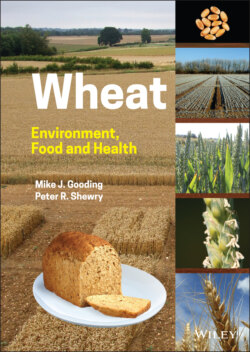Читать книгу Wheat - Peter R. Shewry - Страница 27
1.3.2 Wild Wheats
ОглавлениеChromosome and genetic analysis have facilitated our understanding of the relationships between the wild wheats of prehistory and the cultivated wheats of today. All members of the Triticeae have multiples of a related set of seven chromosomes (genomes), numbered 1–7. Diploid (literally two‐fold likeness) species have two copies of each chromosome (2x = 2n = 14). Some sets of chromosomes are more similar than others and they have thus been grouped accordingly. Those sets of chromosomes relevant to wheat evolution are labelled the A, B, D, G, and S genomes (Figures 1.13 and 1.15; Kihara 1929, 1954; Dewey 1984).
The diploid species carrying the different, but related, sets of chromosomes appear to have diverged between 2.5–4.5 MYA (Huang et al. 2002). Two species of wild diploid wheat (wild einkorn) are found today: Triticum uratu and Triticum monococcum var. boeoticum (Figure 1.15). Both species have the genome formula AA, i.e. they have a diploid complement of the A set.
Although the diploid species are biologically isolated, hybrids have been formed in the Triticeae through allopolyploidy. This is a type of hybridization where the offspring inherit the complete chromosome complement from each of the parents. For example, wild emmer contains four sets of chromosomes, the diploid complement from T. uratu (AA) and the diploid (BB) complement from a type of goat grass (Aegilops spp.). Wild emmer ( Triticum turgidum var. dicoccoides) is therefore an allotetraploid (4x = 28) with genome formula AABB. This allopolyploidy is made possible because the different sets of chromosomes from the diploid species do not pair during meiosis in the polyploids (Chapter 10). Such sets of chromosomes, which are homologous but non‐pairing, are termed homoeologous (Glover et al. 2016), for example, chromosomes 1A and 1B in emmer are homoeologues.
Figure 1.15 Summary of the genome constitutions and evolutionary relationships of the major wild and cultivated forms of wheat (Triticum spp.).
The hybridization to produce wild emmer occurred naturally, possibly between 0.2 and 0.5 MYA (Huang et al. 2002; Gill et al. 2004). A second wild tetraploid species also occurs (Triticum timopheevi var. araraticum) with the genome formula AAGG. Although the B and G genomes are distinct, they are known to be related and both may be derived from the S genome present in the Sitopsis section of Aegilops, with Ae. speltoides being the closest currently existing species. The two tetraploid wheat species may, therefore, have diverged after the formation of an ancestral AASS tetraploid. In fact, Dvořák et al. (2006) considered that the B, G, and S genomes are sufficiently alike to be classed as the same group.
